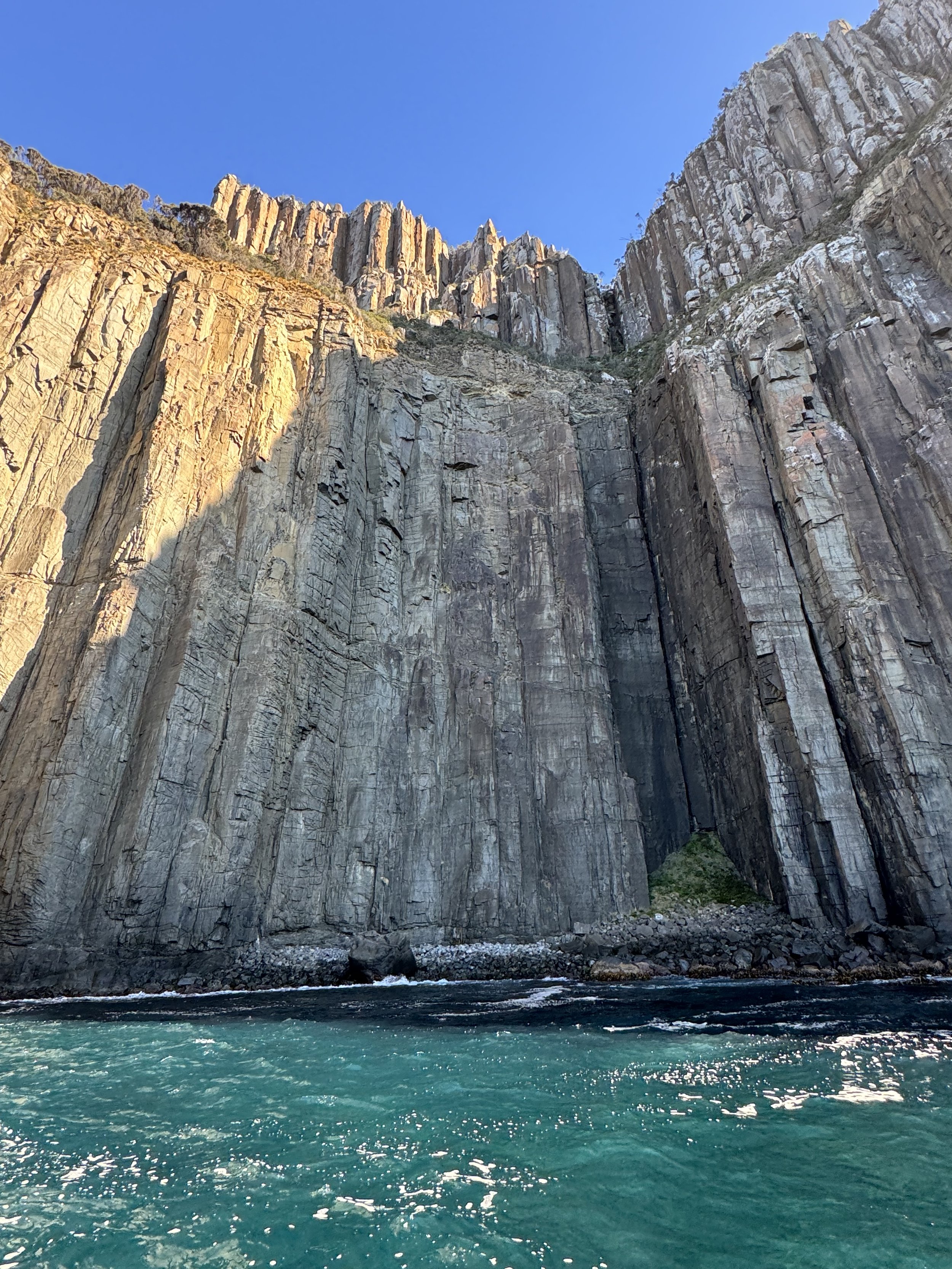Beyond the Brochure
I took another sip of local cherry cider, took another bite of local lamb, and turned the page to digest some more local history of this very island that I had been camping, driving and hiking over. It felt so strange to be comfortably warm and cosy inside the “Hotel Bruny” while reading of the atrocious ways the Nuenonne - the Aboriginal people of Bruny Island - had been treated by the first explorers, then settlers, sealers and convicts. I wanted to sit there until I’d finished the whole book, but the barman informed me it was last drinks. Time to head back to the cold tent.
Nestled off the southeastern coast of Tasmania, Bruny Island (or Lunawanna- Alonnah as it was known to the Nuenonne) beckons with its pristine landscapes and rich biodiversity. Named after French explorer Bruni d'Entrecasteaux, who visited the region in 1792, the island boasts an epic blend of rugged coastlines, towering cliffs, and serene beaches. Home to a small community of residents, Bruny Island also welcomes countless visitors drawn to its untouched wilderness and abundance of wildlife, including fur seals (of which I saw plenty), penguins (of which I saw none, not for lack of trying), and diverse bird species. Renowned for its gourmet food scene the island showcases local delicacies such as freshly caught seafood (I highly recommend “get shucked” oysters!), artisan cheeses, and premium whisky. I had 4 days to play with and I didn’t know if I should drive to the Tasman Peninsula to hike the three capes, or catch the ferry to Bruny. For some reason I found myself driving to Hobart on the Western side of the Derwent River, and decided I would continue that course and catch the ferry to Lunawanna-Alonnah.
Epic Jurassic Dolerite cliffs, SE Bruny Island.
I’m glad I did. Despite the busy flurry of school-holiday traffic off the ferry, by the time I had driven down the winding dirt roads to the secluded Jetty Beach at the bottom of the island, the cars had petered out, leaving me with a peaceful patch of grass to call home, with just some surfing P-platers, Hobart couples, and a cute pair of scarlet robins for camping company. I walked the Labillardiere Peninsula 18km Circuit, the 5.4km epic Fluted Cape Circuit, visited the old lighthouse, and took an awesome boat tour of the South-Eastern cliff-face side of the island. It was all very nice. It was all very wild.
I’m not a reader, but for some reason I bought the book “Truganini: Journey Through The Apocolypse” by Cassandra Pybus. I had heard a little but about Truganini. I had heard that she was the last survivor of Tasmania’s original peoples. I knew that fact alone was false, as I had spent the week before at the Outdoor Health Australia Forum with Palawa people; Tasmanian Aboriginal people, still sharing their history, knowledge and culture. I wondered what other lies I’d been told that the book might uncover.
Tasmania saw significant European exploration in the 17th and 18th centuries. In 1803, the British established a settlement at Risdon Cove, marking the beginning of European colonisation. The island was initially used as a penal colony, with Port Arthur becoming infamous for its harsh treatment of convicts. These harsh stories of the lives of convicts and settlers make the stories of the Palawa people thriving in the Tasmanian landscape for tens of thousands of years even more impressive. I felt brave and accomplished just for having my daily morning swim in the cold sea in mid-autumn! I can’t imagine having the daily woman’s-work of free-diving naked and mask-less for oysters, mussels and crayfish, but that’s what was done.
I’m yet to finish the book, but starting to read “Truganini” on her Country (where the book’s beginning is also set) was surreal. Knowing the bays and mountains mentioned in her story gave the book so much more meaning, and also gave my experience of the place a deeper meaning too. You get a better appreciation of how intense the sea voyages would have been for the first settlers and their Aboriginal captives after seeing the coast by boat. You get a better appreciation for how bountiful the hunting and gathering would have been for the Nuenonne after seeing the abundant wallabies, muttonbirds and oysters by foot.
The Outdoor Health Australia forum that I went to in Tassie a fortnight ago really placed local Palawa people at the front and centre of the whole conference. If we’re to move forward into a way of connecting more with nature, learning from nature, and protecting nature, why not learn all about it from the experts? By experts, I don’t mean the PHD holders in the universities, I mean the original outdoor health practitioners; the ones who knew how to live sustainably with the land as part of Country for millennia. I’m excited to learn more from First Nations people with this business and excited to do a better job of not only elevating Aboriginal history and culture, but paying back. Keep me accountable as I work to decolonise this space.
Travel is so much more meaningful and has so much more depth when we can appreciate what’s been before. The wildlife and landscape hold so many stories in this so-called “young” country, and I encourage you all to learn them, even when it takes a bit more digging beyond the tourist brochure. You’ll be rewarded.
You can buy Pybus’ book here, or request it at a library near you.


